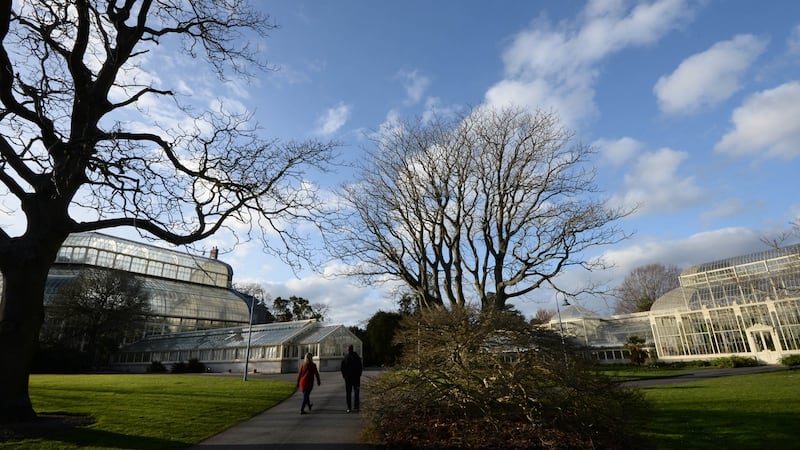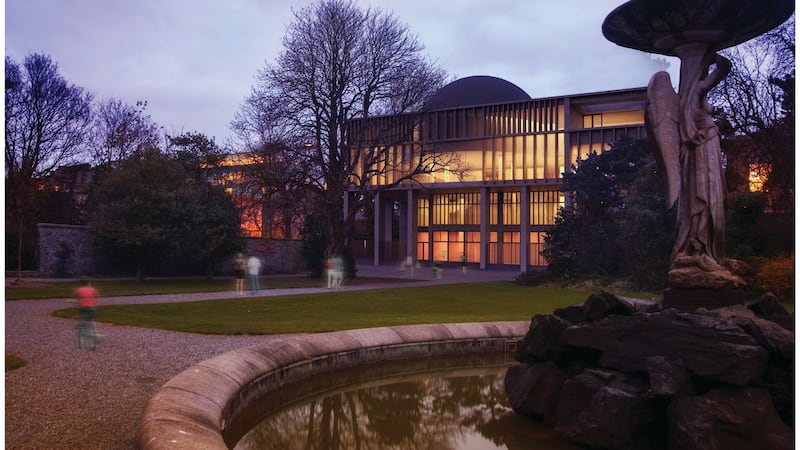Ciarán O'Connor is a man with a mission. Hugely ambitious, he rose up through the Office of Public Works to become its principal architect nearly eight years ago, and he's just taken over as president of the Royal Institute of the Architects of Ireland for a two-year term with an agenda that embraces climate change, the fallout from Brexit and the increasing "digitisation" of nearly everything we do.
Even Irish bathrooms will be affected by Brexit. "Did you know that 40 to 50 per cent of the sanitary ware [baths, washbasins, toilets] we use here comes from Britain? We'll have to find new suppliers from Europe for all of that. Also, 40 per cent of the timber we use in construction comes in through Britain from Scandinavia, so that'll probably have to be reorganised as well," he says.
OPW architects are finalising a practical, user-friendly “green design” guide for publication this summer, and O’Connor is “prepared to share it with everyone” in the construction industry. As the State agency with responsibility for more than 2,000 buildings, “we know a lot about how they perform”, so designing for energy efficiency, comfort and life cycle will rank high in the priorities.
But the design guide will not be saying that timber is the preferred solution, not least because Ireland is a relatively damp country where exposed timber doesn't wear well; just look at the blackened Samuel Beckett Theatre in Trinity College. And while concrete is much more carbon intensive, it needs less maintenance and lasts much longer, thereby offsetting the emissions produced in its manufacture.
Designing for “climate resilience and sustainability” is also a core element of the Government’s latest architecture policy, Places for People, which is open for public consultation until January 31st. Although full of aspirations and platitudes, with no real targets, Ciarán O’Connor still sees it as “vital” and says he’s “optimistic that we will get enough of a grip on it to turn the aspirations into action”.
Even though he holds the grandiloquent title of “State architect”, he’s quite circumspect when asked about planning guidelines aimed at promoting high-rise buildings in Irish cities and towns, preferring to frame it in terms of achieving a Copenhagen-style urban density well-served by public transport. “We need to develop that more nuanced, more sophisticated approach . . . not just ad hoc and all go.”
With a Dutch-born wife, he also knows the Netherlands well. "The Dutch are very good at long-term planning. They have a proper dialogue, whereas we have too much monologue here, and you need a level of sophistication to engage in dialogue about urban density and the services it can support. We need to start moving in that direction, but how to make it happen is easier said than done."
My happiest moments were working in the Bots
I first met O'Connor nearly 30 years ago when he was working on the restoration of Richard Turner's Curvilinear Range in the National Botanic Gardens. This followed a 1989 report in The Irish Times documenting how one of the most important historic buildings in Ireland – chosen to represent the 19th century in a definitive An Post stamp series – was falling into serious decay.
How its restoration happened is also a typically Irish story. O'Connor had surveyed the glasshouse while he was a fourth-year architecture student in Bolton Street College of Technology, so he knew it well. He had also grown up in Finglas and knew the gardens in Glasnevin well, and then found himself years later restoring its architectural centrepiece, which was then in a "pretty ropey" state.

"My happiest moments were working in the Bots," he says. Bertie Ahern was minister for finance at the time and O'Connor knew that he took his two young daughters for a walk in the gardens every Sunday. So he buttonholed him there, gave him a walking tour of the decrepit Curvillinear Range and ultimately secured £4.5 million in funding to restore this outstanding building as faithfully as possible.
Some of its wrought-iron elements – all made at Turner's Hammersmith Works in Ballsbridge – were in such decay that they couldn't be reused. His Temperate House in Kew Gardens, London, had been replaced by a stainless steel replica, and O'Connor discovered that all of the discarded wrought iron was still there, so he made an offer of £1,500 for the lot – and then "repatriated" it to Ireland.
He went on to design the National Botanic Gardens' visitor centre and herbarium as well as restoring its Great Palm House, with only the Aquatic House still needing major work. As the OPW's principal architect, he insists on having a central role in designing all major projects, such as the recently completed Garda divisional headquarters for Dublin's south inner city, on the corner of Bride Street and Kevin Street.
Raised over a double-basement containing the obligatory private car parking for gardaí as well as cells, interview rooms and other facilities, the €28 million building sets a new standard for Garda stations. With its sweeping curve on Bride Street, it cantilevers over a ground-floor that offers little animation other than what O’Connor calls the “rhyming rails” – lines from Irish poets etched on painted steel.
It replaces the city's oldest police barracks in the former Palace of St Sepulchre, official residence of successive archbishops of Dublin from 1184-1804. Currently used by the Emergency Response Unit, the old palace is due to be evacuated when a new Garda Security and Crime Operations Centre is built near the Royal Hospital Kilmainham, after which it will be restored for a "cultural role".
Planning for this new complex on the east side Military Road, leading up to the former hospital’s gates, ran into strong criticism because of the way it was handled under Section 9 of the 2000 Planning Act, which excludes any public right of appeal. However, O’Connor insists that all third-party observations were examined by an external assessor and provision was made for a cycleway running in front of the building.

Controversy also erupted over Exploration Station, the proposed national children's science centre beside and behind the National Concert Hall on Earlsfort Terrace – first earmarked for the Military Road site. Claims were made that it would destroy the relative tranquillity of Iveagh Gardens, an urban oasis for strollers and dog-walkers that's been used for concerts and other events in recent years.
But O’Connor insists that removing part of the wall separating the Earlsfort Terrace site from the gardens to expose the principal elevation of Exploration Station will actually reinstate a landscape originally created for the Dublin Exhibition in 1865, when a great glasshouse faced towards the gardens. “That natural link was lost when the boundary wall was built, and we’re trying to reconnect it,” he says.
He is equally enthusiastic about a competition-winning pedestrian bridge by London-based architect Ian Ritchie – originator of the Spire on O'Connell Street – to span the river Liffey between Conyngham Road and Edwin Lutyens' War Memorial Gardens at Islandbridge, which he describes as "an odd cultural cul de sac". The bridge would also tie in with plans to restore the Phoenix Park's Magazine Fort.
Although Conyngham Road is a hostile place for pedestrians, O'Connor sees it being bridged in time to provide a safe route from the War Memorial Gardens to the Phoenix Park and points out that there are also plans for a cycleway along the river in Islandbridge. "What's the added value we can create? Can one good idea do three or four things?," he asks rhetorically. "That's the brains and beauty of architecture."
As for persistent complaints that talented young Irish architects are excluded from competitions by restrictive rules, he suggests that this could be overcome by entering joint ventures with more established practices to tender for State projects. The OPW is also setting up panels of architects on a regional basis from which designers will be selected for building projects; “the helping hand”, he calls it.
We need to get back to having more public discussion about architecture
O'Connor declined to comment on the massive cost overrun on the national children's hospital, other than saying that he wasn't consulted about the project. Neither was the OPW involved in the fiasco over the Oireachtas's new printing machine, even though it has just completed a major restoration of Leinster House. If it was, one imagines the first thing it would have done was to establish the dimensions.
One of his major cribs is that architecture is no longer being critically examined or even acknowledged in the media, despite the extraordinary success of Grafton Architects' founders Yvonne Farrell and Shelley McNamara in curating the widely-acclaimed Venice Biennale in 2018 and winning Britain's Royal Gold Medal. "We need to get back to having more public discussion about architecture," he says.
Have your say on the Government's draft architecture policy at chg.gov.ie/heritage/built-heritage/architectural-policy/










